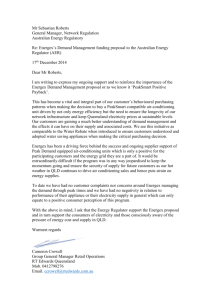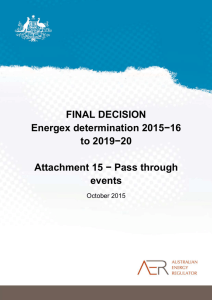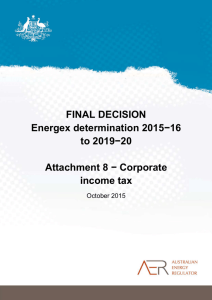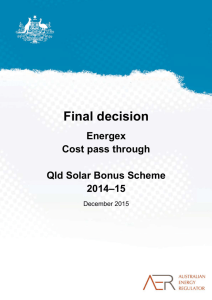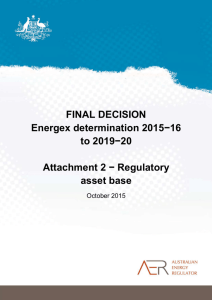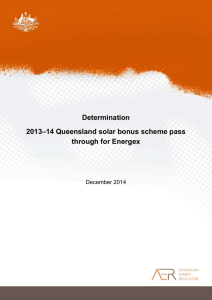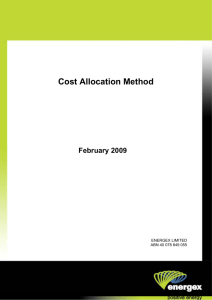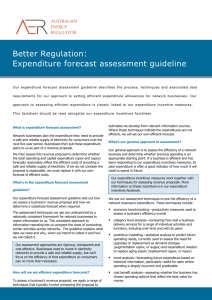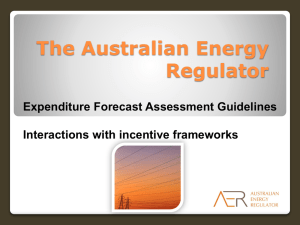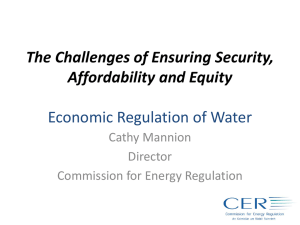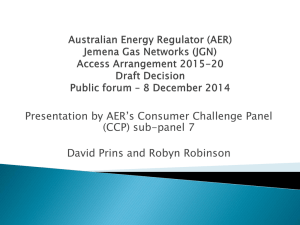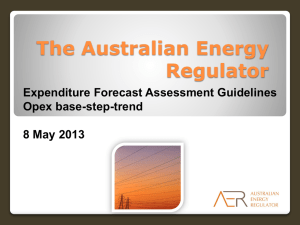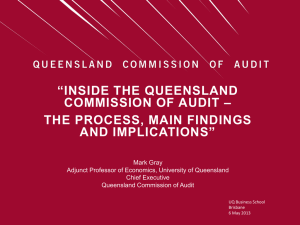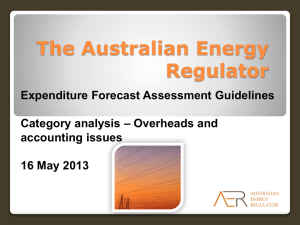Fact sheet - Final decision Energex final distribution determination
advertisement
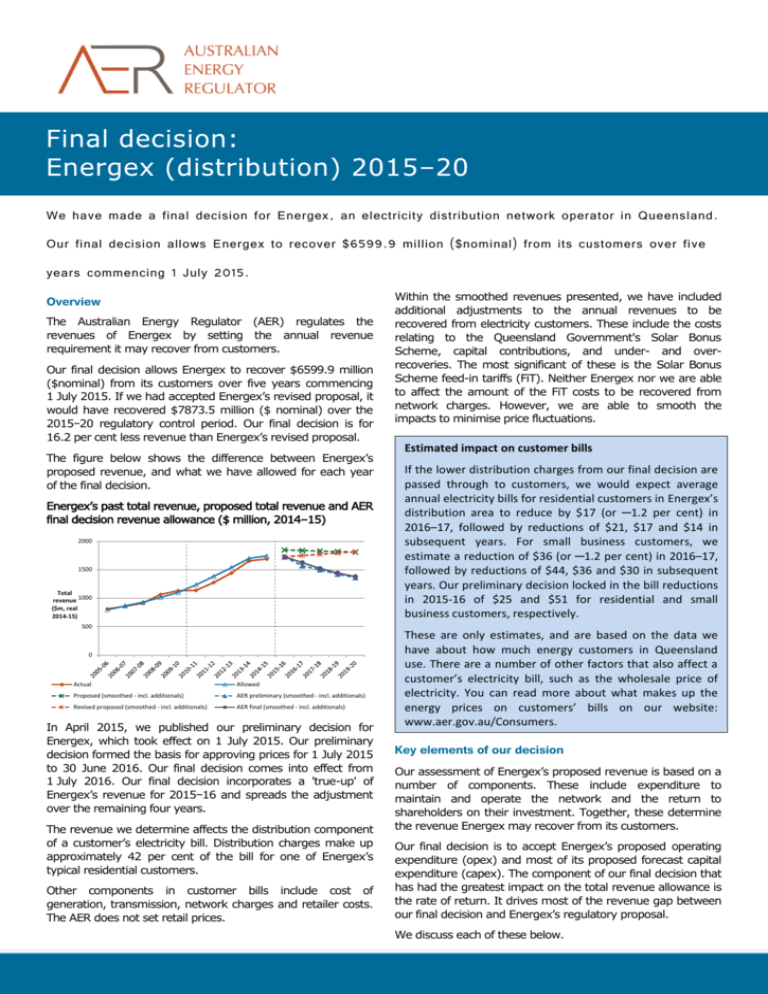
We have made a final decision for Energex, an electricity distribution network operator in Queensland. Our final decision allows Energex to recover $6599.9 million ($nominal) from its customers over five years commencing 1 July 2015. Overview The Australian Energy Regulator (AER) regulates the revenues of Energex by setting the annual revenue requirement it may recover from customers. Our final decision allows Energex to recover $6599.9 million ($nominal) from its customers over five years commencing 1 July 2015. If we had accepted Energex’s revised proposal, it would have recovered $7873.5 million ($ nominal) over the 2015−20 regulatory control period. Our final decision is for 16.2 per cent less revenue than Energex’s revised proposal. The figure below shows the difference between Energex’s proposed revenue, and what we have allowed for each year of the final decision. Energex’s past total revenue, proposed total revenue and AER final decision revenue allowance ($ million, 2014–15) 2000 1500 Total revenue 1000 ($m, real 2014-15) Within the smoothed revenues presented, we have included additional adjustments to the annual revenues to be recovered from electricity customers. These include the costs relating to the Queensland Government's Solar Bonus Scheme, capital contributions, and under- and overrecoveries. The most significant of these is the Solar Bonus Scheme feed-in tariffs (FiT). Neither Energex nor we are able to affect the amount of the FiT costs to be recovered from network charges. However, we are able to smooth the impacts to minimise price fluctuations. Estimated impact on customer bills If the lower distribution charges from our final decision are passed through to customers, we would expect average annual electricity bills for residential customers in Energex’s distribution area to reduce by $17 (or ─1.2 per cent) in 2016–17, followed by reductions of $21, $17 and $14 in subsequent years. For small business customers, we estimate a reduction of $36 (or ─1.2 per cent) in 2016–17, followed by reductions of $44, $36 and $30 in subsequent years. Our preliminary decision locked in the bill reductions in 2015-16 of $25 and $51 for residential and small business customers, respectively. 500 0 Actual Allowed Proposed (smoothed - incl. additionals) AER preliminary (smoothed - incl. additionals) Revised proposed (smoothed - incl. additionals) AER final (smoothed - incl. additionals) In April 2015, we published our preliminary decision for Energex, which took effect on 1 July 2015. Our preliminary decision formed the basis for approving prices for 1 July 2015 to 30 June 2016. Our final decision comes into effect from 1 July 2016. Our final decision incorporates a 'true-up' of Energex’s revenue for 2015−16 and spreads the adjustment over the remaining four years. The revenue we determine affects the distribution component of a customer’s electricity bill. Distribution charges make up approximately 42 per cent of the bill for one of Energex’s typical residential customers. Other components in customer bills include cost of generation, transmission, network charges and retailer costs. The AER does not set retail prices. These are only estimates, and are based on the data we have about how much energy customers in Queensland use. There are a number of other factors that also affect a customer’s electricity bill, such as the wholesale price of electricity. You can read more about what makes up the energy prices on customers’ bills on our website: www.aer.gov.au/Consumers. Key elements of our decision Our assessment of Energex’s proposed revenue is based on a number of components. These include expenditure to maintain and operate the network and the return to shareholders on their investment. Together, these determine the revenue Energex may recover from its customers. Our final decision is to accept Energex’s proposed operating expenditure (opex) and most of its proposed forecast capital expenditure (capex). The component of our final decision that has had the greatest impact on the total revenue allowance is the rate of return. It drives most of the revenue gap between our final decision and Energex’s regulatory proposal. We discuss each of these below. Rate of return Capital expenditure Significant investment is required to build a distribution network. The return Energex must pay lenders and investors is referred to as the rate of return. Even a small difference in the rate of return can have a big impact on revenues. Capex refers to the cost of building new facilities or replacing existing infrastructure. Factors that influence our required level of capex include the age and condition of existing assets. Our final decision sets the allowed rate of return (or ‘cost of capital’) at 6.01 per cent for 2015−16. We have not accepted Energex’s proposal of 7.42 per cent. The investment environment has improved since our previous Queensland distribution decision in 2010, which was made during the period of uncertainty surrounding the global financial crisis. This improved investment environment translates to lower financing costs necessary to attract efficient investment. We consider that Energex has sought a rate of return that is higher than necessary given the current investment environment. In our final decision we did not accept the methodology proposed by Energex to set its rate of return. Instead, we have used our methodology developed with extensive consultation during our Better Regulation program in 2013. We consider that our approach provides for a rate of return that better reflects the allowed rate of return objective. The lower rate of return in this decision will reduce Energex’s average annual revenue requirement compared to the past. We must be satisfied that the level of capex proposed by Energex reflects the capex criteria: the costs that a prudent operator—with efficient costs and a realistic expectation of demand and cost inputs—would need to operate its network safely and comply with its obligations and service standards. We have estimated total forecast capex of $2755.4 million ($2014−15) for Energex’s 2015−20 regulatory control period. This is 4.6 per cent lower than Energex’s proposal of $2889.7 million ($2014−15) for capex. Energex’s forecast capex includes less expenditure on new assets to grow its network than in previous periods, because of slower demand growth. Notwithstanding this reduction, our capex estimate includes lower expenditure on augmentation (or upgrades) of the network and connections. We are satisfied that our estimate will allow Energex to comply with its regulatory obligations and requirements and maintain the safety and reliability of its distribution network. AER final decision compared to Energex’s past and proposed capex ($million, 2014-15) Operating expenditure Opex includes forecast operating, maintenance and other non-capital costs that Energex is likely to require during the 2015−20 regulatory control period for the efficient operation of its network. Our final decision allows Energex to recover $1738.2 million ($2014−15) for opex. In reaching our final decision we have compared Energex’s opex proposal with our alternative estimate of total opex. While we have reached a different position on specific elements that make up the opex forecast, our final decision is to accept Energex’s forecast of total opex. That is, overall, we are satisfied that Energex’s level of forecast opex reflects costs that a prudent operator—with efficient costs and a realistic expectation of demand and cost inputs—would need to operate its network safely and comply with its obligations and service standards. AER final decision compared to Energex’s past and proposed opex ($million, 2014-15) For more information: More information on our final decision can be found on our website: www.aer.gov.au.
